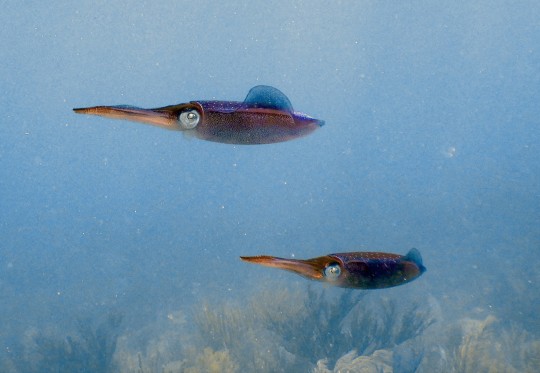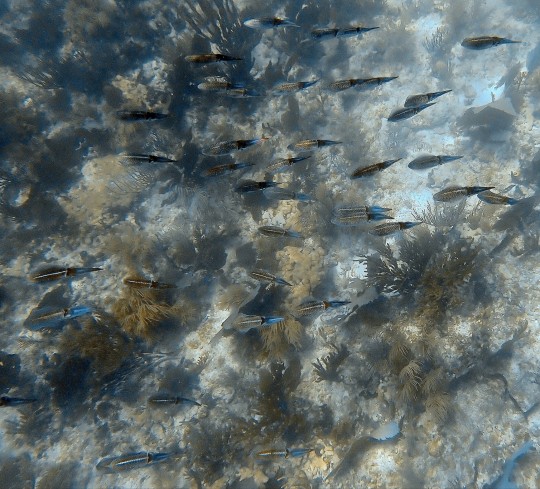Mollusc mayhem with a side of pain. OC blog | 18+ to follow Please | CW: drugs, self-harm, violence (among other sensitive topics!) Sheezy: @shellsiege | if you read this far hi :)
Last active 4 hours ago
Don't wanna be here? Send us removal request.
Text

whatever (x)
29 notes
·
View notes
Text


Squids are unique among cephalopods in their tendency to aggregate in shoals for purposes other than mating! Humboldt squid are the most infamous for their pack-like hunting coordination, but these Caribbean reef squid shoal likely for defensive reasons! In complex groupings of mixed age groups and sex, it's very interesting to watch as they communicate with their skin patterns and postures - often unique across different parts of their bodies facing different neighboring individuals!
1K notes
·
View notes
Note
og anon who asked for the cannibalism tag: fair!! I wasn't sure how totally relevant it was, I was just sorta surprised when reading some of the overviews. I'm not totally adverse to the topic, it was more just that I like having warnings for subjects <3 but it's all good!! I'm in here for the long haul haha, I enjoy your art and world building :)
It's a good idea to always ask and thank you!
0 notes
Text

Lions don't have to watch out for much with bold warning colors and spines that pack a venomous punch to anything trying for a sneak attack. Even the claws of these creatures are capable of delivering a sting, so they're well-protected. While they lack the respectable set of fangs present for most carnivorous finfolk, they get by just fine swallowing small prey whole, most of which consists of small invertebrates they pry out of cracks and crevices using their long fingers.
9 notes
·
View notes
Note
i have to ask. you mention alot of the fin/ink folk being predatory and hunting, are they still eating each other now? or is this a past history thing?
The species overviews are presented in a very naturalistic way, so they approach the species accordingly by describing them by their role in the ecosystem and behavior in the wild, which is a long-winded way to say that most of it is barely relevant in the concept of modern interspecies societies and especially eating other sapients is largely turbo illegal and immoral. If you went back in time several (MANY) thousand years, you would arrive at a point where society as a whole didn't exist yet and interspecies languages or communication were in their infancy, and that's where you could probably accurately apply the descriptions to reality. In the current day, murder is very illegal and every sapient folk is protected under this law, so you're not going to have much luck trying to hunt somebody unless you want to also go to jail or be ostracized for the rest of your life. Of course you'll occasionally run into predation in criminal circles or recent periods of war among other things, but all of this is to say that if you do run into it, it's definitely not legal or socially acceptable, and you won't find inkfolk meat packaged on store shelves (unless you went out of your way to find an extremely morally dubious store with uncertain and suspicious product origins).
Since I assume the next natural question is "then what do the predators eat now?", the answer is non-sapient animals as well as seafood. Invertebrates such as crustaceans and bivalves are farmed en masse and those make up a huge amount of the general food supply, but you also have both aquatic and terrestrial fish, and if you're flat broke you're probably eating canned jelly (which isn't that nutritious but at least it's edible).
2 notes
·
View notes
Text

Most inkfolk are venomous to some degree, and they're not afraid to advertise it. Though even in the absence of venom, you probably want to avoid that beak... it's built for piercing and tearing. Luckily, inkfolk usually make it pretty obvious when they're unhappy. You could say they wear their emotions on their face or rather the whole head.
83 notes
·
View notes
Text

Finned Octofolk
Finned octofolk, sometimes referred to as cirrates, are very different from almost all other inkfolk. While their body plan is similar, their crown tentacles are located on their necks, they are scavengers rather than active predators, and they have neither chromatophores nor an ink sac. The primary habitat of these creatures is the arid desert, where they emerge in the dark of night to survey the sand for small invertebrates and potential leftovers from hunts that occurred during the day.
15 notes
·
View notes
Note
would u be willing to add cannibalism to your trigger warning tags? :O
I've added a content warning mention for it to the introductory post, but I won't be tagging individual mentions. I will assume cannibalism in this sense refers both to actual cannibalism (in-species) as well as predation between sapient folk (which i think i defined as cannibalism in the modern worldbuilding). It's pretty obsolete outside of the specific species overviews I've been posting, so you should see a minimal amount of it if you don't read about the predators. Though if you're sensitive enough to the topic to not want to see or think about it at all, then following a cephalopod-centric project is generally not something I'd recommend 😭
2 notes
·
View notes
Text


Three (3) lovely types of finfolk in the house today!
Codfolk are large, predatory finfolk that are abundant in the Northern reaches of the continent. Due to an adaptation for producing antifreeze proteins in their bodies, they thrive even in areas where the temperature routinely dips below freezing.
Pufferfolk consist of two different types of finfolk; the fugu (A) and puffers (B). These finfolk are quite similar in many ways, the most notable of which being the inflatable throat sac that is used for threat displays, defense and vocalization. For the inexperienced, this throat sac is probably the best way to tell these finfolk apart, with the spines of fugu typically lying flat against the skin while at rest and being quite short even when spiked out, while the spines of puffers are rigid and clearly visible even with the throat sac deflated.
11 notes
·
View notes
Text

Giant Octofolk Across the Continent
Among octofolk, there are three species that tower over the others in size with a minimum height of just around 2 meters. With their large size and terrifying strength, they occupy a high trophic level and are able to prey on a wide range of creatures, including inkfolk and even other top predators such as sharks. While not particularly fast or agile, giant octofolk use their arms or crown tentacles to effortlessly subdue anything they capture.
Found in the Western Continent, the frilled giant (A) is abundant particularly in the North. It is morphologically extremely similar to the Eastern giant (B), which is found all the way across the continent on the Eastern coasts and the Northeast, with the two types of giant octopus primarily separated by the sizes and shapes of their papillae as well as minute differences in patterns. The horned giant (C) is not directly related to the two other giant octofolk, but is still routinely included in the classification due to being significantly larger than other octofolk, with size overlap with the other two giant octofolk.
18 notes
·
View notes
Text

like to lend him $50 share to lend him $50 ignore to let him starve
12 notes
·
View notes
Text

What is she thinking about... correct answers only
#oc: peppy#gallery#inkfolk#gif#i actually dont enjoy walk cycles. but this was zen. pro tip just do it badly but do it
14 notes
·
View notes
Text
We have landed in Icon Land and we have a dedicated icon now instead of Funny Image. lets see if it sticks
2 notes
·
View notes
Text

Kids take being <1 meter tall for granted... you'll miss it when you're the height of the average ceiling.
16 notes
·
View notes
Text












Wave 3 of my artfight 2025 attacks!!!!! for @zhou-bot-a, @milksoapy, honeyhunter, kelpkq on bluesky, @blazingbaboon, @knightmare-fantail, stoyahoy on bluesky, @cupozo, Kawfy, @tertain-the-original, paralich on artfight, and @shellsiege/DODOKOIRA on Sheezy!
#WHAG I SEE THIS BEFORE GOING ON ARTFIGHT EVEN#ENGELLL tysm for drawing him 😭😭#oc: engel#the crocs are making me crazy this is awesome.#also love all the cephalopods going on here<3
7 notes
·
View notes
Text

imagine eating a sickly octopus' shrimp dog.... well i shan't imagine much longer
11 notes
·
View notes
Text

Reef Squidfolk
The Western Reef Squid (A) and the Eastern Reef Squid (B) are morphologically very similar, even down to the patterns. However there's some slight differences, mostly in the standard coloration of the mantle and fins, that can be used to tell them apart. While both species have iridescent spots, these typically take the form of distinct stripes on the mantle of the Eastern Reef Squid (which sometimes earns it the name of "tiger squid").
6 notes
·
View notes